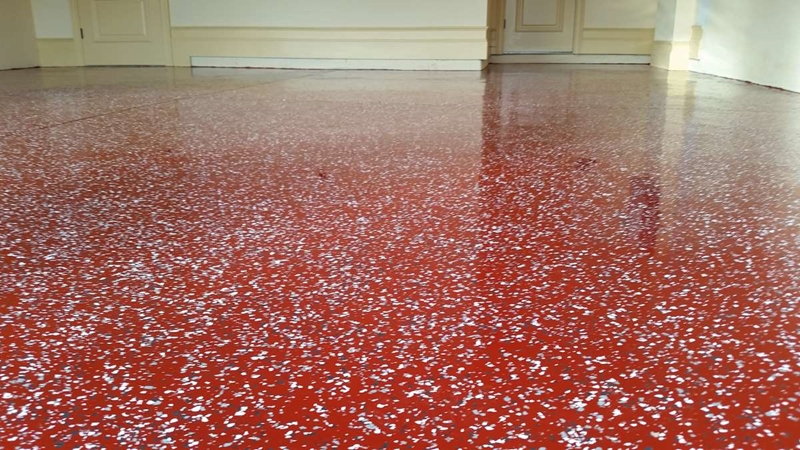Polyaspartic polyureas are fairly new in the marketplace and have great potential for decorative concrete because their many exceptional qualities distinguish them from other coatings on the market. Contractors are using them as clear coats over finishes such as stamped, stained, colored, and stenciled concrete and pigmented coatings, including decorative media. There is also some experimenting with applications on exterior slab-on-grade decorative work.
HISTORY
Aspartic esters were invented and patented by Bayer Corporation in the 1990s. Aspartic resins followed, and the manufacturer found that very dense and shiny films could form, leading to the creation of polyaspartic aliphatic polyureas. Now several companies have introduced formulations that contractors can use commercially. Their formulations share several common properties, but there are also benefits and cautions unique to each product on the market.
Polyureas are 2-component coatings. The system functions when a resin is mixed with a catalyst, a polyisocyanate, which provokes a reaction and forms a polymer compound.
REMARKABLE PROPERTIES
The benefits of a polyaspartic floor coating put classic epoxy floors to shame. Not only are they of higher quality, longer-lasting, and much more damage resistant, but polyaspartic/polyurea floors cure in a fraction of the time it takes an epoxy floor to cure. The latest coating technology has brought many new floor coating chemicals with extraordinary features compared to conventional materials:
- Depending on the product, they can be applied at temperatures as low as -30°F and as high as 140°F. In hot and cold climates, contractors can install them all year long.
- Polyureas have much greater abrasion and impact resistance than epoxy or urethane coatings.
- They do not blush or whiten.
- Curing is fast, and work can be turned over to homeowners within a couple of hours after application.
- High ambient humidity does not restrict the application, although some products set more quickly in high humidity.
- Polyureas have exceptional wetting and penetrating characteristics, which means they form exceptional bonds to concrete. They don’t stain, resist fat and oil penetration, and protect concrete from mild acids.
- When cured, they can endure temperatures as high as 350°F.
- They are UV light stable, delivering “water clear” finishes.
PREPARING CONCRETE
There are various thoughts among applicators about the preparation needed for concrete applications. The type of application also counts. But it can’t be argued that the excellent “wetting” ability of polyaspartic polyureas and the way they penetrate concrete makes low profile preparation for decorative concrete likely.
These “wetting” characteristics allow concrete penetration on the first application, providing amazing bond strength.
Some contractors profile their concrete with grinders using 40 to 80 grit diamond pads. We recommend removing the cement paste from the surface and neutralizing all soluble salts. Entirely cleaning with a power washer may be adequate for decorative concrete acquiring a thin film coating.
Many applicators have found that applying a citric acid wash and pressure washing with a turbo tip to prepare slabs before staining. The preparation is good when the primary coat absorbs completely into the surface. We have not heard of any scaling, debonding, or other problems involving polyurea coatings.
MOISTURE CONTENT IN CONCRETE?
The most vulnerable part of concrete is the sealer. Polyaspartic polyureas solve this issue. They are heat-resistant, waterproof, stain and acid resistant, and don’t soften with fats or oils. Polyureas don’t transmit water vapor, so they are considered waterproof. Aspartic ester polyureas “wet out” and infiltrate concrete surfaces to achieve a superior bond. This bonding ability may prevent moisture vapor transmission issues. The moisture content of the concrete shouldn’t exceed 3 pounds per 1000 square feet using the calcium chloride test at the time of application to ensure that the primer application will penetrate the surface properly.
APPLICATION
The application process incorporates three coatings; a primer (which penetrates the surface but is not always vital, a “build coat” containing the decorative application if it’s more than a clear coat, and a topcoat. It should consist of 20 to 25 mils in thickness when you contain vinyl chips in your finish. 6 to 8 mil thicknesses are normal and provide “hiding capacity” when pigments are counted.
Polyaspartic polyureas are sold as 100% solids material, with solvents added or recommendations for adding solvents. With the acquisition of solvents, the material is less dense, pot life increases, and penetration into a slab proliferation.
Another advantage of polyaspartic polyureas is that the material doesn’t outgas. Concrete still traps air, though, and it can escape into a coating after it’s applied. It’s best to apply coatings when ambient temps are dropping. But because they set so quickly, there is less likelihood of trapping air in polyureas.
Humidity accelerates setting time. When this product is applied at 40% humidity, the setting time might be 30 to 40 minutes. But at 90% humidity, it can decrease to 15 minutes.
If you would like to learn more about ArmorThane’s Polyaspartic ArmorFloor product, click here. ArmorThane will be happy to answer any questions you have!

